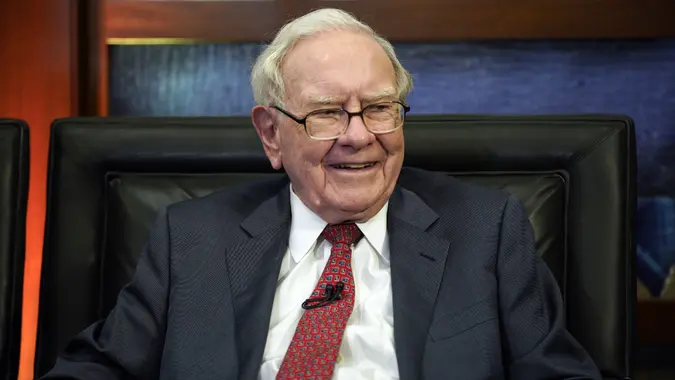How to Invest 1000 Dollars: Best Options For 2025

Commitment to Our Readers
GOBankingRates' editorial team is committed to bringing you unbiased reviews and information. We use data-driven methodologies to evaluate financial products and services - our reviews and ratings are not influenced by advertisers. You can read more about our editorial guidelines and our products and services review methodology.

20 Years
Helping You Live Richer

Reviewed
by Experts

Trusted by
Millions of Readers
If you’ve got $1,000 sitting in the bank, you may be wondering what to do with it. You could buy a new phone or book a weekend getaway — but if you’d rather grow that money, investing could be a smart move.
While $1,000 might not seem like a life-changing amount of money, it could provide a solid foundation to start building wealth and a great starting point to get your feet wet with investing.
In this guide, we’ll walk you through how to invest 1000 dollars, even if you don’t have expert-level financial knowledge.
Why Invest $1000?
Thanks to compounding interest, even a small investment can grow over time. Plus, as you watch your wealth build, it might motivate you to make a habit of investing.
The earlier you start, the more time your money has to grow. It also lets you take advantage of market fluctuations.
Before investing, think about what you eventually want to use the money for, for example:
- Buying a home
- Going on a vacation
- Getting married
- Preparing for retirement
Once you know your objectives, it will be easier to decide how to invest 1000 dollars (we’ll go in-depth on this later).
Best Ways to Invest $1000
Below is an overview of some common types of investments so you can find the best way to spend $1,000:
1. Stock Market: Buying Shares in Companies
Pros:
- Potential for high returns
- Liquidity and diverse investment options
- Potential for dividends
Cons:
- Volatility in the market
- Risk of losing entire investment
- Limited control over company decisions
How to get started: Open an account with a brokerage like Fidelity or Vanguard. Research companies thoroughly and diversify with different stocks, industries and sectors.
Ideal investment timeframe: Long-term is best (typically five or more years) to minimize risk and maximize returns.
2. Mutual Funds & ETFs: A Diversified Approach
Pros:
- Instant and easy diversification
- Professionally managed
- Lower fee options with ETFs vs. mutual funds
Cons:
- Mutual funds may have higher fees or minimums
- Potential for tracking errors with ETFs
- Both investments are subject to market risk
How to get started: Use a brokerage platform or robo-advisor. Compare fees and check for minimum investment requirements.
Ideal investment timeframe: Medium to long term (three to 10 years or longer)
3. Bonds: A Safer, Steady Option
Pros:
- Less risk than with stocks
- Regular interest income
- Moderate returns
Cons:
- Lower returns than with stocks
- May fluctuate with interest rate changes
- The issuer could pay back the bond early (resulting in less interest)
How to get started: Decide which type of bond you want (treasury, municipal, corporate, savings, etc.). You can buy them through a brokerage, your retirement account or directly from the U.S. government.
Ideal investment timeframe: Short to long-term (one to 10 years or more), depending on the term and type of bond.
4. Real Estate Crowdfunding: Investing in Property Without the Hassle
Pros:
- Access to real estate investing without high upfront costs
- Potential for passive income
- No need to manage properties yourself
Cons:
- May have asset requirements to participate
- Less liquid than stocks
- Risk of market fluctuations
How to get started: Join one of the best real estate crowdfunding platforms, like Fundrise, RealtyMogul or Groundfloor. Research what type of real estate you want to invest in and the requirements and fees of different platforms.
Ideal investment timeframe: Long-term (Fundrise recommends investing for five years or longer).
5. High-Yield Savings Account (HYSA) or Certificate of Deposit (CD)
Pros:
- Higher returns than with traditional savings accounts
- Deposits are typically insured
- Easy access with HYSAs or fixed interest rates with CDs
Cons:
- Potentially lower returns compared to stocks
- Early withdrawal penalties on CDs
- Variable rates with HYSAs
How to get started: Open an account with an insured online bank like SoFi or Ally. Shop for the highest interest rate and compare balance requirements and fees.
Ideal investment timeframe: Short to medium-term (less than five years).
6. Robo-Advisors: Automated Investing Made Easy
Pros:
- Hands-off and beginner-friendly
- Diversified portfolio, often including mutual funds and ETFs
- Lower fees than with traditional advisors
Cons:
- Fewer investment options
- No human advisor to answer your questions
- At risk of market fluctuations
How to get started: Sign up for a service like Ally, Betterment or Fidelity. Fill out its questionnaire about your goals, risk tolerance, how much you plan to invest, etc.
Ideal investment timeframe: Short to long-term (long-term is best so you can wait out any market downturns).
7. Invest in Yourself: Education or Skill Development
Pros:
- May lead to career advancement
- Could result in a higher income
- Builds your skills and confidence
Cons:
- Takes time and discipline
- May require taking on student loan debt
- Return on investment isn’t guaranteed
How to get started: Enroll at your local community college or look for online courses through Udemy or LinkedIn Learning. Research which skills are in demand or consider what would help you move up the ladder at your current job.
Ideal investment timeframe: Short or medium-term (a few months to four years).
8. Build an Emergency Fund
Pros:
- Provides a safety net for surprise expenses
- May prevent you from taking on debt in an emergency
- Gives you peace of mind
Cons:
- Low returns with traditional savings accounts
- May not outpace inflation
How to get started: Open an account with an FDIC-insured bank or NCUA-insured credit union. Compare interest rates and watch out for balance requirements or monthly fees.
Ideal investment timeframe: Ongoing (must be accessible at all times; replenish as soon as possible if you use the funds).
9. Pay Down High-Interest Debt
Pros:
- Reduces how much interest you’ll pay
- Frees up income for other investments
- Can improve your credit score
Cons:
- Won’t directly grow your money
- Not as exciting as investing
How to get started: Choose whether to focus on the highest-interest debts first or the smallest balances. Make extra payments on each debt until you pay it all off.
Ideal investment timeframe: Immediate to long-term (however long it takes to pay off the debt).
10. Invest in a Retirement Account (IRA or 401(k))
Pros:
- Tax advantages (deductible contributions or tax-free withdrawals)
- Compound growth over decades
- Prepares you for retirement
Cons:
- Maybe penalties for withdrawing before age 59 ½
- Limits on how much you can contribute
How to get started: You may be able to sign up for a 401(k) with your employer. You can go through to open a traditional or Roth IRA.
Ideal investment timeframe: Long-term (penalties if you withdraw early).
11. Peer-to-Peer Lending (P2P)
Pros:
- Potentially higher returns than traditional savings accounts
- Can add diversification to your investment portfolio
- Requires a lower investment to get started
Cons:
- Risk of borrowers defaulting
- Some P2P lending platforms may charge fees
- Less liquidity than other investments
How to get started: Sign up for a P2P lending platform like Upstart. Choose which loans you want to fund based on risk ratings and interest rates.
Ideal investment timeframe: Short to long-term (loan options could range from two to six years).
Risk vs. Reward: What to Know
Risk is the possibility of losing some (or all) of your money or earning less than expected. All investments come with risk — even a savings account is at risk of inflation outpacing returns.
Generally, the more risky an investment, the better its returns will be. By diversifying your funds and investing them longer, you can often reduce your risk exposure.
When figuring out how to invest 1000 dollars, you can choose the right level of risk for you by considering your goals for the money, investment timeline and comfortability in waiting out market fluctuations.
Saving vs. Investing: Which Is Better for $1000?
Saving money involves setting it aside in a safe, low-return place like a savings account with FDIC or NCUA insurance.
Investing, on the other hand, focuses on growing your money long-term by taking more risks.
If you might need the money relatively soon, like for an upcoming wedding, you should usually save it. It’s also best to build an emergency fund with three to six months’ expenses before you start investing.
However, if you already have an emergency fund and your goals with the money are more long-term (like preparing for retirement), you might consider investing where there’s more growth potential over time.
Since savings accounts pay low interest rates on average, they’re generally not a good option for long-term growth. Investing, on the other hand, can provide substantially higher returns in the long run.
It’s also important to note that you should pay off any high-interest debt before investing. If the stock market sees 10% in annual returns, but your credit card interest rate is 30%, you’ll save money by paying off that debt first.
Short-Term vs. Long-Term Investments
When deciding how to invest 1000 dollars, consider your time horizon, which is how long you want to leave the money invested.
If you might need that $1,000 within the next five years, you’ll want to keep it somewhere safe and accessible, like a high-yield savings account, CD or short-term bonds. That way, you won’t have to sell at a loss when you need the money.
However, if you can keep it invested for more than five years, you might consider longer-term investments, like stocks, mutual funds or ETFs. Although these investments are riskier, you can wait out market fluctuations if you don’t need the money right away.
Common Mistakes to Avoid When Investing $1000
There are a few common investing blunders to avoid when deciding how to invest 1000 dollars:
Not diversifying your investments
Many new investors get excited about a potential investment opportunity and put all of their money toward that one thing. However, if something were to happen, such as the company going under, you could lose your investment.
A better strategy is to balance your portfolio by investing across different industries, sectors and asset types. For example, you might invest some money in stocks, bonds, real estate and P2P lending.
Diversification doesn’t guarantee profits, but it may help minimize the risk of major losses. It’s one of the smartest steps to take if you have $1,000 to invest.
Waiting too long to invest
If your money sits idle, you might miss out on the power of compound growth. Time is your greatest asset with investing, so it’s best to start as soon as possible.
Inflation can also erode the value of your cash over time, which means your dollar won’t stretch as far in the future. Investing that money could earn a return that outpaces inflation.
So, instead of waiting for the “perfect time” to invest, it’s best to jump in as soon as possible (if it aligns with your goals and financial situation) is best.
Trying to time the market
Timing the market is when you attempt to buy low and sell high. While this sounds like a great idea, it can be incredibly challenging to accomplish.
Stock prices are influenced by several factors and tend to experience wild price swings. Trying to time the market can easily end in substantial losses, even for experienced investors.
Investing a fixed amount over time is typically a better idea, regardless of market conditions. The downturns and upswings of the market tend to level out in the long run, so you’ll often see steady growth with your investments over time.
Final Take to GO
If you’re trying to decide how to invest 1000 dollars, you have several options depending on your goals. Some of the best include a high-yield savings account, stocks, mutual funds or a retirement account like a 401(k) or IRA.
The most important thing is to start investing early to take advantage of compound growth. Also, remember to be patient — time is your best asset when it comes to building wealth.
As you learn more about investing, you’ll become more confident about what money moves to make.
FAQ: How to Invest 1000 Dollars
Here are some common questions and concerns around investing:- Can I make a lot of money by investing $1000?
- You likely won’t grow your $1,000 substantially overnight, but you can earn a solid return over time through compound growth.
- Should I invest in individual stocks or funds?
- When deciding how to invest 1000 dollars, funds may be better if you're low on time so you can have easy diversification and management. However, if you love reading about investing, you might be successful with buying individual stocks.
- How long will it take to grow $1000 with investing?
- It depends on the type of investment you choose and its performance. The average return in the stock market, for example, is 10% per year historically. So, in theory, if you invest $1,000, you could potentially earn $100 within the first year.
The information is accurate as of April 1, 2025.
Editorial Note: This content is not provided by any entity covered in this article. Any opinions, analyses, reviews, ratings or recommendations expressed in this article are those of the author alone and have not been reviewed, approved or otherwise endorsed by any entity named in this article.
Our in-house research team and on-site financial experts work together to create content that’s accurate, impartial, and up to date. We fact-check every single statistic, quote and fact using trusted primary resources to make sure the information we provide is correct. You can learn more about GOBankingRates’ processes and standards in our editorial policy.
- U.S. Securities and Exchange Commission "Diversifying Risk"
- Experian "What Is an Investment Time Horizon?"
- Experian "The Pros and Cons of Buying Bonds"
- Investor.gov "Certificates of Deposit (CDs)"
- FDIC "National Rates and Rate Caps"
 Written by
Written by  Edited by
Edited by 

























